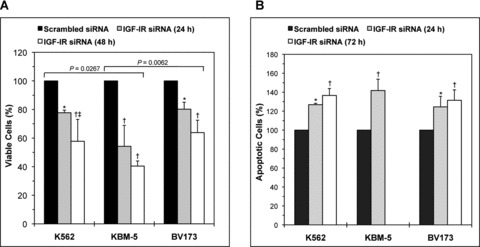Fig 4.

Specific blockade of IGF-IR decreases cell viability and induces apoptosis in CML cell lines. (A) IGF-IR siRNA decreases the viability of K562, KBM-5 and BV173 cell lines. The decrease in cell viability is time-dependent and becomes more pronounced at 48 hrs after transfection of the cells. At 24 hrs, the KBM-5 cell line appears to be more sensitive to the effects of IGF-IR siRNA when compared with K562 and BV173. *: P < 0.05 and †: P < 0.001 versus control untreated cells and ‡: P < 0.05 versus IGF-IR siRNA (24 hrs). Comparing the collective effect of IGF-IR siRNA on decreasing the viability of the K562 and BV173 cell lines versus KBM-5 demonstrated that P= 0.0002. (B) IGF-IR siRNA increases apoptotic cell death in K562, KBM-5 and BV173 cell lines. The effect of IGF-IR siRNA is pronounced in the KBM-5 cell line at 24 hrs after transfection and, therefore, additional analysis at 72 hrs was not performed. For the K562 and BV173 cell lines, after 72 hrs apoptosis became equally similar to KBM-5.at 24 hrs. *: P < 0.01 and †: P < 0.001 compared with control untreated cells. Statistical significance was not achieved when individual cell lines were compared but comparing the collective effect of IGF-IR siRNA on apoptosis showed a slightly more significant response in KBM-5 cells versus K562 and BV173 (P= 0.048).
